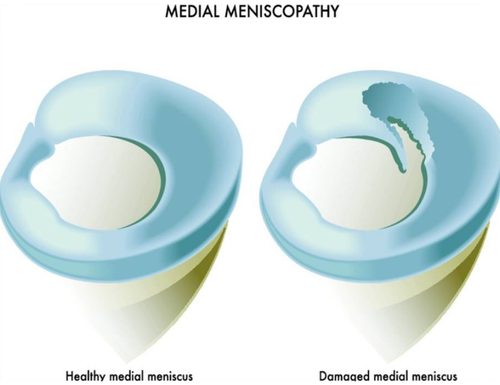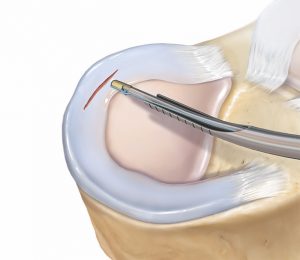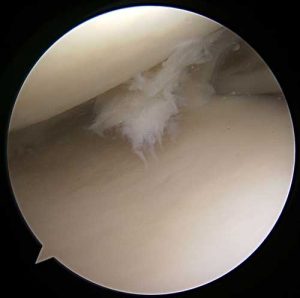Meniscal Tear and Meniscus Damage
A meniscal tear can occur either due to wear and tear or acute trauma. Mixed forms are common.

What is the Meniscus?
The meniscus is located in the knee joint, with an inner and outer meniscus present. The menisci are located on the sides of the knee joint between the upper and lower leg, directly on the cartilage covering. They consist of elastic fibrocartilage that can adapt to the movements of the knee joint.
The inner meniscus has a “crescent-shaped” appearance and, unlike the outer meniscus, is firmly fused to the joint capsule and the medial collateral ligament. This increases the relative susceptibility of the inner meniscus to injury.
The outer meniscus is C-shaped and, compared to the inner meniscus, is only partially fused to the joint capsule. It has no direct contact with the lateral collateral ligament. This makes it more mobile and less susceptible to injury.
Meniscus Damage – Cause
Most meniscus injuries are caused by pre-existing damage and less frequently by trauma. Over the course of life, the structure of the meniscus changes and it loses elasticity. A degenerative change is the result – mucoid degeneration.
Meniscal Tear – Symptoms
If a meniscus is torn or ruptured, it leads to a mechanical blockage of the knee joint, which can take on different dimensions. Patients usually complain of pain when bending the knee joint in the area of the inner hollow of the knee, when “squatting“, and when sitting in a tailor’s seat.
If a torn meniscus portion is displaced in the knee joint, this can lead to complete joint blockage. Progressive meniscal tears are common. Simple meniscal tears can turn into complicated ones if left untreated.
Meniscus Tear – Diagnostics
The clinical examination is very meaningful in the case of meniscus ruptures. Tests are carried out that specifically apply pressure and shear forces to certain meniscus areas, which allows lesions to be localized exactly. The exact representation of the meniscus lesion is done using magnetic resonance imaging. Additional injuries such as ligament ruptures or cartilage damage can be determined more precisely with this.
A meniscal tear is often accompanied by a bloody knee joint effusion, which can be very painful and should be punctured.
A rapid clarification by means of clinical examination, MRI and the initiation of the correct therapy are of great importance in order to prevent consequential damage. A typical consequential damage is the Baker’s cyst.
Meniscal Tear – Therapy
A symptomatic meniscal tear should be treated surgically, as self-healing or fusion of the tear does not occur. During arthroscopy, the extent of the injury can be assessed via two 5 mm skin incisions.
With specially thin and multiple angled instruments, it is possible to operate minimally invasively even in very small or narrow knee joints in such a way that the cartilage covering is not touched in any way. This prevents pressure damage to the cartilage.
A conservative therapy is possible for small degenerations or tears that do not reach the meniscus surface. Appropriate physical therapy is required to alleviate the symptoms.
Meniscus refixation for meniscal tear
 If the meniscus is freshly torn, as much substance as possible must be preserved.
If the meniscus is freshly torn, as much substance as possible must be preserved.
With special suture anchor systems, it is possible to perform a meniscus-preserving procedure in purely arthroscopic technique. This can significantly reduce consequential damage (osteoarthritis).
Meniscus transplantation
Meniscus replacement with collagen meniscus implant
The meniscus transplantation is used when an injured meniscus can no longer be surgically reconstructed. Instead of just removing the damaged meniscus tissue, a meniscus transplant is inserted, which takes over the original function after healing. Here, the whole meniscus, as well as only a part of the meniscus, can be replaced.
Follow-up treatment meniscus transplantation
After a meniscus transplantation, it is very important to follow the follow-up treatment program exactly.
Postoperatively, you must wear a splint. The operated knee may only be slightly stressed for 6 weeks. Physiotherapy is necessary. You can start with building sports 3 months after the operation. Full athletic loads are allowed 6 months after the operation.
For further information and personal advice, please contact us. We look forward to seeing you!

Dr. Mark Schurz
CONTACT
